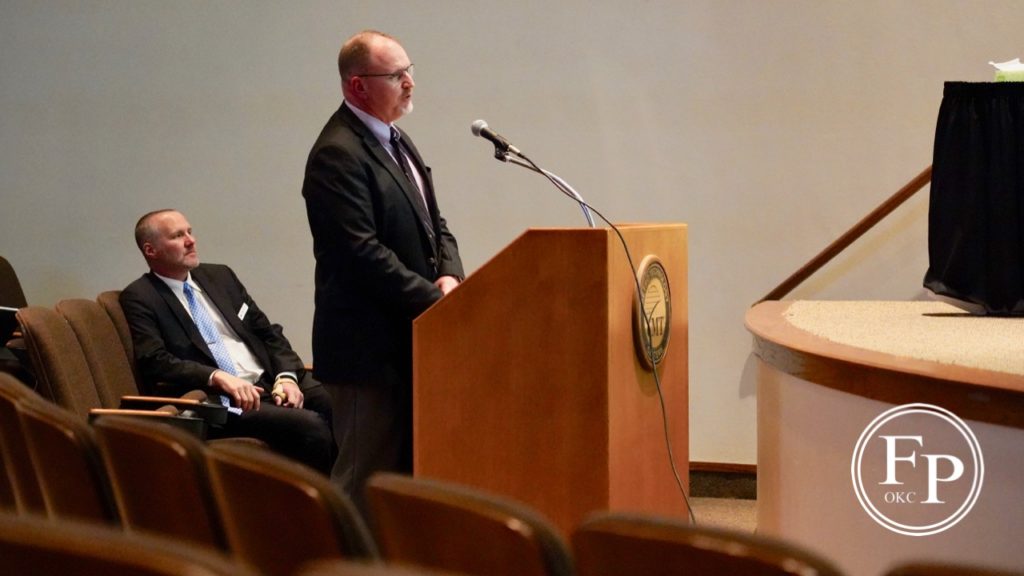Last Updated on February 13, 2020, 8:24 PM | Published: February 13, 2020
Monday, the OKCPS Board of Education encountered what Superintendent Sean McDaniel termed “brutal facts” about suspensions in the largest, most diverse school district in Oklahoma.
Those facts were presented in response to a series of questions Board members asked the administration to answer.
The district is still struggling to make progress at lowering the number of suspensions this school year even when it has been making a concerted effort to improve overall discipline numbers since 2016.
Increase in suspensions
Free Press reported January 17 that first-semester suspensions in the district were 4,184 this school year, a 37% increase over the same time last school year.
Some numbers provided by the district in mid-January were different from the report Monday night.
Monday night, Charles “Chuck” Tompkins reported a total of 4,048 suspensions in the first semester.
Tompkins was hired to be the director of the School Climate and Student Discipline department which was established to coordinate compliance with a U.S. Department of Education resolution with the district signed in April 2016 and meant to correct inequities in the district’s discipline systems.
But, from his report Monday, serious questions remain about the effectiveness of the district’s efforts to correct problems identified in the resolution.

The number of suspensions in the first semester of this school year is about 300 above those recorded in the first semester of the school year ending in 2015.
Suspensions in 2015, then considered excessive, became a benchmark for meeting the terms of the resolution, often referred to by district staff as “OCR” or Office of Civil Rights Resolution.
Office of Civil Rights Resolution
Excessive suspensions and expulsions of black and Latino males in 2012 prompted an investigation later by the Office of Civil Rights (OCR) in the U.S. Department of Education.
The result was the April 2016 resolution committing to a series of actions meant to correct the imbalance.
“The goal of the District is to ensure that all District students are provided schools that are safe and create an environment conducive to learning,” the first line of the resolution read.
In the resolution, the district also promised to create a system where policies and procedures would “ensure that disciplinary sanctions do not include the loss of educational instruction time for any students,” except to guard the safety of other students.
Then, every year through 2018, OKCPS measured the breakdown of who was being suspended and for what reasons under the supervision of Tompkins. The resolution also required an extensive regimen of meetings to determine school climate and how the district could improve meeting the needs of its students.
Then and now
Issues that dogged the district at the beginning of the decade are still struggles at the end of it.
The red-flag issue that drew so much OCR attention in 2012 resulted in some students being suspended for such long periods that the district strained to make a case that they were being educated.
Measuring in number of days suspended out of school first semester in 2015, African American students received the most suspended days out of school at 8,512.
The second highest, Hispanic students came in second that year with 6,243 with third place taken by white students at 2,104.
The order in the first semester of this 2020 school year hasn’t changed. African American students received 6,764 days suspended out of school, Hispanic students received 4,691 and white students received 1,150.
Board member concerns
Several Board members weighed in on the issues of suspensions during Monday’s Board meeting.
Gloria Torres, who has been an administrator in OKCPS several years ago, led off with concerns about whether teachers – predominantly white – really understand the culture of the students they are teaching no matter what part of the city they are in.
Ruth Veales pointed to the ongoing problem of African American students still being the highest demographic spending time away from any classroom. She also mentioned the concern Torres had about how few teachers were people of color and how many students were.
Carrie Jacobs asked about vague categories of “disrespect” and “disruptive behavior” which can be interpreted very differently from one teacher to another and from one principal to another. She called for the “subjective” categories in referrals to be eliminated to cut down on confusion among students, teachers, and principals.
Mark Mann was concerned about the wide differences in referrals in verticals.
Charles Henry asked several administrators about the structure and expectations in the schools insisting that not enough is demanded of students to participate in their own education with self-discipline.
“Brutal facts”
When we asked McDaniel after the meeting if he thought progress had been made, he wasn’t sure. So far, he has not tried to minimize the size of the discipline problem in the district.
“I don’t know that it represents progress,” said McDaniel. “I mean, I think what we were trying to accomplish today was, let’s face some of our brutal facts.”
“Let’s acknowledge, here’s where we are. So that now we can move forward.”
He said that the district has to respond to concerns about discipline that are being raised in the community, among parents, and among teachers.
One of his big concerns was to clearly identify what the core of the problem is, and the numbers given at that board meeting were a start.
“There are red flags all over the place with regard to student behavior,” said McDaniel. “So, let’s identify the issue.”
McDaniel was concerned about the disparity between what some of the data is showing and what they are hearing from teachers, students, staff, and parents.
The goal? “The ideal that we’re shooting for is that when we talk to people in the schools, and we look at the data it tells the same story.”
He said that the main way that would happen is through “training and accountability.”
But, the district has to believe that training on things like implicit bias has to be valued more at the district level.
“So, when we talk about implicit bias training or even classroom management, if we say in the next sentence, hey, we’re going to offer it on Tuesday night at four o’clock, hope you can make it – which is kind of what we’ve been doing – the message from the district is it’s really not that important,” said McDaniel.
Powerpoint slides from Charles Tompkins’ presentation
BOE-Meeting-2-10-2020-Discipline-and-ClimateFounder, publisher, and editor of Oklahoma City Free Press. Brett continues to contribute reports and photography to this site as he runs the business.










